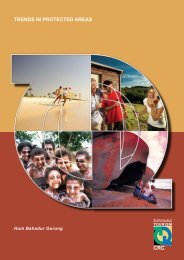icolls - Sustainable Tourism CRC
icolls - Sustainable Tourism CRC
icolls - Sustainable Tourism CRC
Create successful ePaper yourself
Turn your PDF publications into a flip-book with our unique Google optimized e-Paper software.
ECOLOGY, THREATS AND MANAGEMENT OPTIONS FOR SMALL ESTUARIES AND ICOLLS<br />
biomass accrual that escapes the grazing capacity of herbivores (including zooplankton), leading to the<br />
proliferation of algal biomass (Perissinotto, Nozais & Kibirige 2002). When planktonic biomass becomes<br />
excessive, algal blooms can result (Lenanton, Loneragan & Potter 1985; Pollard 1994a). In instances where this<br />
biomass accrual is excessive, the aesthetic appeal of the ICOLL may be significantly reduced (Welch, Jacoby,<br />
Horner & Seeley 1988; Martins, Pardal, Lillebo, Flindt & Marques 2001).<br />
Given the capacity of estuaries to act as nutrient sinks, it is likely that a large proportion of increased primary<br />
production will be processed within estuaries and, more specifically, result in increased secondary production<br />
(Hall, Frid & Gill 1997). However, should algal production occur to such an extent that it inhibits or modifies<br />
habitat structure, there may be adverse effects on food web structure and energy processing. For example, a<br />
reduction in key submerged flora such as seagrasses may be devastating to the components of the food web that<br />
rely on aquatic vegetation for food and/or shelter (Connolly 1997; Webster, Rowden & Attrill 1998; Deegan,<br />
Wright, Ayvazian, Finn, Golden, Rand Merson & Harrison 2002; Hovel 2003). In addition, changes in seagrass<br />
and macroalgal production may alter habitat and food resource quality for grazers (Murias, Cabral, Marques &<br />
Goss-Custard 1996; Winning, Connolly, Lonergan & Bunn 1999; Deegan 2002). The eutrophication of estuaries<br />
and the die-off of seagrass and dugongs from coastal areas have been linked to high exports of nutrients and/or<br />
sediments from catchment disturbance (Udy & Dennison 1997; Cappo, Alongi, Williams & Duke 1998;<br />
McComb & Humphries 1992; Dennison, Orth, Moore, Stevenson, Carter, Kollar, Bergstrom & Batiuk 1993).<br />
In an ICOLL with an open connection to the ocean, as for macrotidal estuaries, nutrient inputs may also<br />
stimulate algal growth responses. However, given the additional hydrologic complexity owing to tidal flushing<br />
and potential dilution and loss of nutrients to the marine environment, it is likely that algal blooms will either<br />
disperse or require considerably greater additions (per unit time) to form and persist (Martins et al. 2001).<br />
Recent research has highlighted this influence of hydrology on the processing and consequences of nutrient<br />
inputs in ICOLLs (Philip Haines PhD, pers comm). Significantly, management of ICOLLs for nutrient and<br />
associated algal blooms typically relies upon modifications to entrance status to the extent that blooms and<br />
excessive nutrients are removed via artificial opening events. To date there have been no investigations of the<br />
ecological consequences of artificial manipulation of entrance berms, yet manipulation remains the key<br />
mechanism through which authorities manage nutrient and algal problems. The capacity of ICOLLs to<br />
adequately process increased algal production through grazing food chains has not been investigated. However,<br />
given the combined effects of nutrient inputs and reduced flow in ICOLLs, it is unlikely that grazers will be able<br />
to adequately consume increases in algal biomass following the excessive nutrient inputs that characterise many<br />
of these systems (Hall, Frid & Gill 1997; Edgar & Barrett 2000; Tappin 2002).<br />
Contamination<br />
The variety of contaminants in estuarine sediments and biota is immense (Johnson, Landahl, Kubin, Horness,<br />
Myers, Collier & Stein 1998; Edwards, Edyvane, Boxall, Hamann & Soole 2001; Lewis, Moore, Goodman,<br />
Patrick, Stanley, Roush & Quarles 2001; Silva, Rainbow, Smith & Santos 2001; Lauenstein, Cantillo &<br />
O'Connor 2002). Heavy metals such as mercury, lead, copper, zinc and cadmium are present in many of the<br />
world’s coastal waterways (Edwards et al. 2001; Lauenstein et al. 2002). Chlorinated and organic pesticides<br />
from agricultural applications have been shown to reach unsafe quantities in coastal systems in North America<br />
(Kosatsky, Przybysz, Shatenstein, Weber & Armstrong 1999) and Brazil (de Brito, Bruning & Moreira 2002).<br />
Limited data for Australian coastal waterbodies also indicates substantial agricultural and/or industrial<br />
contamination (Cappo et al. 1998). Whilst agricultural and industrial sources of contaminants have traditionally<br />
dominated inputs into estuaries, there is increasing concern over the delivery of contaminants to waterways from<br />
urban developments (Stark 1998; Morrisey et al. 2003).<br />
Ecological and human health consequences of contaminants<br />
Contaminants are likely to influence the ecological structure and function of estuaries and ICOLLs in a number<br />
of ways. Contaminants can directly influence the survivorship of aquatic species and therefore the composition<br />
of benthic communities (Gaston, Rakocinski, Brown & Cleveland 1998; Inglis & Kross 2000; Pospelova,<br />
Chmura, Boothman & Latimer 2002). In addition, contaminants accrue in estuarine sediments (Zann 2000;<br />
Lewis et al. 2001; Morrisey et al. 2003) and bioaccumulate in food webs (Hanrahan, Falk, Anderson, Draheim,<br />
Kanarek, Olson & The Great Lakes Consortium 1999; Nikolova Eddins 2001; de Brito, Bruning & Moreira<br />
2002; McKinney, Lake, Charpentier & Ryba 2002). Furthermore, when contaminants bind to sediments in<br />
estuaries, they can inhibit nutrient cycles (McAuliffe, Lukatelich, McComb & Qiu 1998; Flindt, Pardal, Lillebo,<br />
Martins & Marques 1999; Pinay, Clement & Naiman 2002; Rozan, Taillefert, Trouwborst, Glazer, Ma,<br />
Herszage, Valdes, Price & Luther 2002). Reduced availability of these nutrients can in turn threaten fisheries<br />
production and ecosystem processes, through reduced primary production upon which consumers like fish and<br />
5











